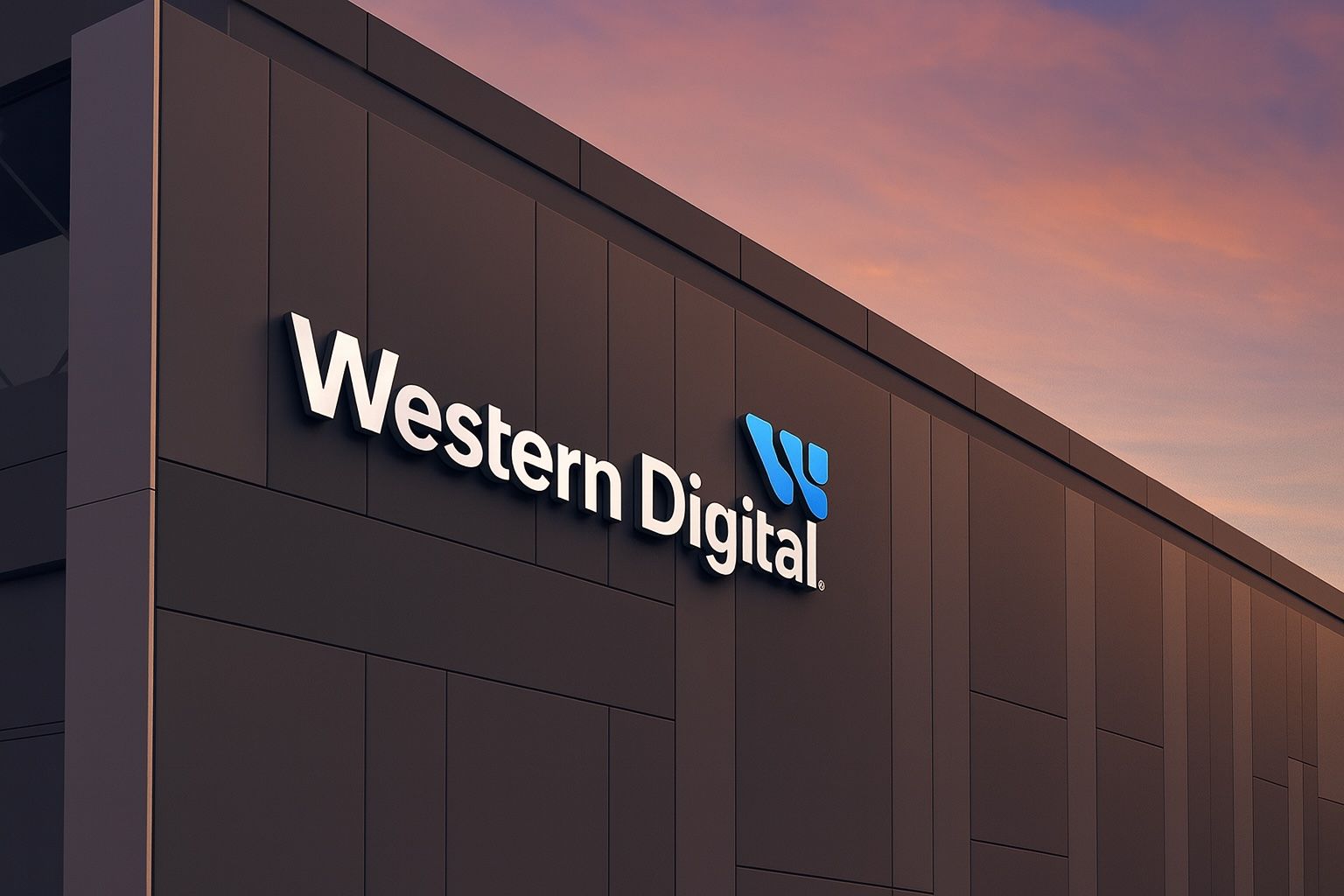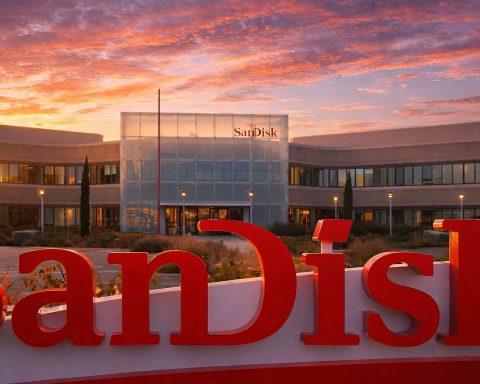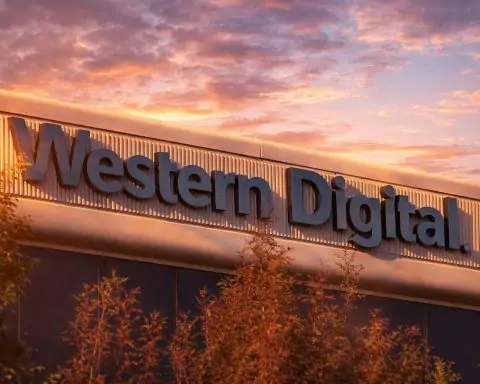- SanDisk’s Journey & Acquisition: SanDisk Corporation (formerly NASDAQ: SNDK) was a pioneer in flash memory and saw its stock soar in the early 2000s with booming NAND flash demand. Facing intense competition and industry cyclicality by the mid-2010s, SanDisk agreed to be acquired by hard-drive giant Western Digital (NASDAQ: WDC) in 2016 for roughly $15.8 billion in cash and stock [1]. The deal (originally valued near $19 billion before a financing change) gave SanDisk shareholders a lucrative exit and Western Digital a foothold in the fast-growing flash storage market.
- Western Digital’s 2016 Bet on Flash: The acquisition, completed in May 2016, transformed Western Digital from a disk-drive stalwart into a broader storage leader. Western Digital was the largest U.S. hard-disk drive (HDD) maker (~44% market share vs Seagate’s 40% at the time) [2] and was grappling with declining PC demand for HDDs. Buying SanDisk instantly made WDC one of the world’s largest flash memory providers, positioning it to ride the shift toward solid-state drives (SSD) and cloud storage [3]. Western Digital projected significant synergies (about $500 million in 18 months) and expected the deal to be accretive to earnings in year one [4].
- Historical Performance Volatility: In the years after 2016, Western Digital’s stock saw volatile swings reflecting the notorious boom-bust cycles of the memory market. WDC shares initially traded around $75 at the time of the SanDisk buyout, but integration challenges and a NAND glut later sent the stock tumbling below $50 within a year. Conversely, during a flash shortage in 2017–2018, Western Digital’s stock surged above $90 as memory prices spiked, only to crash again when oversupply hit in 2019. This cyclicality underscored that Western Digital’s fortune was now tied not just to HDDs but also to the NAND flash cycle, which can swing sharply with global supply/demand imbalances [5] [6].
- 2022–2023 Downturn and Recovery: The most recent cycle was especially dramatic. In 2022 and early 2023, NAND flash and DRAM prices collapsed to all-time lows, with chips selling below production cost amid a post-pandemic glut [7] [8]. Memory makers including Western Digital’s flash unit were forced into drastic production cuts to stem losses [9]. These cuts, combined with steady growth in data demand, set the stage for a sharp rebound: by late 2023, NAND spot prices had doubled off their lows in just six months [10]. Western Digital’s own retail SSD prices jumped – for example, its 2TB Black SN850X drive climbed from holiday sale lows to over $150 by early 2024 [11]. This marked the beginning of a cyclical upswing that would gather momentum in 2024–2025.
- WDC’s 2025 Resurgence – Stock Doubles on AI Boom: Fast forward to 2025, and Western Digital is in the midst of a major resurgence. The stock has roughly doubled in 2025, recently hitting all-time highs [12]. In fact, WDC and rival Seagate (NASDAQ: STX) have been among the top-performing S&P 500 stocks this year, each up around 150–160% year-to-date by early Q4 2025 [13] [14]. The catalyst? Explosive AI-driven demand for data storage. As hyperscale cloud firms and AI labs deploy next-gen AI models, they require massive volumes of storage – both high-speed flash for training data and high-capacity HDDs for longer-term retention. Western Digital recently notified customers of HDD price increases due to “unprecedented demand” in the AI era [15]. Both WDC’s HDD and flash divisions are benefiting from this surge, and the market has re-rated these stocks sharply higher in anticipation of “stronger for longer” growth in the storage sector [16].
- Financial Turnaround in 2024–2025: Western Digital’s financials in 2025 reflect a solid turnaround from the trough of the memory cycle. After posting losses in the flash downturn, WDC returned to growth: in the June quarter, revenue jumped 30% year-on-year [17]. For fiscal 2025 (ended mid-2025), Western Digital reported $9.52 billion in revenue, up 51% from the prior year [18], as both flash and HDD demand recovered strongly. Gross margins have rebounded (Q4 FY25 GAAP gross margin 41%, up from ~35% a year earlier) [19]. Western Digital even resumed shareholder payouts – initiating a dividend and a $2 billion stock buyback in mid-2025 – a sign of management’s confidence in future cash flows [20]. This financial upswing has coincided with Western Digital’s stock rally and has given the company breathing room to address its debt (WDC paid down $2.6B in debt in Q4FY25) [21].
- Strategic Split – Spinning Off Flash (SanDisk) Unit: A major strategic development is Western Digital’s decision to split into two independent companies. In late 2023, after talks to merge WDC’s flash business with Kioxia (formerly Toshiba Memory) stalled, Western Digital’s board – under pressure from activist investor Elliott Management – approved a plan to spin off the flash division (essentially the SanDisk business) by the second half of 2024 [22] [23]. CEO David Goeckeler (at the time) acknowledged that separating flash and HDD will “unlock significant value for shareholders” and allow each unit to pursue its own strategic focus [24]. The spinoff, structured as a tax-free split, effectively unwinds the 2016 SanDisk merger by making the flash arm a standalone firm again [25]. Western Digital’s share price jumped on the announcement (+7% that day) [26], reflecting investor optimism that the sum-of-parts valuation of two focused businesses will exceed the current combined entity. The new flash company – which many expect will revive the SanDisk name – could attract a different investor base, while Western Digital’s remaining HDD business can concentrate on its core competency.
- Flash Memory & Storage Industry Outlook: The flash memory and broader data storage industry are at a pivotal point in 2025. After several years of volatility, demand drivers are exceptionally strong going forward, albeit matched with familiar cyclicality risks. Key trends include:
- AI and Cloud as Demand Catalysts: Nearly every analyst agrees that the rise of artificial intelligence is a game changer for storage demand. Training advanced AI models (like large language models) requires petabytes of data storage, both in fast SSDs and in cheap bulk storage for “cold” data [27] [28]. Cloud computing giants (Amazon, Microsoft, Google, etc.) are dramatically scaling up capacity – a recent deal by OpenAI to purchase up to 900,000 DRAM wafers from memory suppliers underscores the scale of AI’s appetite [29]. Enterprise AI and cloud infrastructure spending is expected to remain robust (and even be revised upward) in coming years, directly translating to growing demand for flash memory and high-capacity drives [30] [31]. Traditional drivers like mobile devices, IoT, and PCs remain factors, but the center of gravity has shifted to data centers and AI workloads in 2025.
- From Glut to Shortage – Cyclical Swing: The industry has pivoted from oversupply to tight supply. In 2022–23, memory makers faced a brutal glut, writing off inventory and slashing capex [32]. Now, thanks to disciplined production cuts and roaring demand, supply-demand balance has flipped. Analysts warn of looming shortages of NAND flash and DRAM that could last years [33]. In fact, manufacturers are cautiously balancing output – mindful that over-expansion after past booms led to price crashes – so the current upcycle may see prolonged tightness. By 2024, NAND and DRAM prices had already started climbing off their lows [34]. TrendForce notes that nearline (data center) HDDs are on allocation with lead times of a year due to shortage, which in turn pushes some cloud providers to buy more flash arrays, further tightening NAND supply [35] [36]. For the first time in recent memory, both HDDs and SSDs are constrained at once, whereas historically one would be a cheaper substitute when the other got pricey [37]. This synchronous tightness bodes well for storage vendors’ pricing power in the near term.
- Competitive Dynamics & Consolidation: The quest for scale and cost-efficiency has led to industry consolidation. Only a handful of players remain in NAND flash (Samsung, Kioxia/Western Digital, SK Hynix/Solidigm, Micron) and in HDDs (essentially Western Digital and Seagate duopoly). Western Digital’s attempted merger with Kioxia would have created a flash behemoth controlling about 1/3 of the global NAND market [38]. That deal was scuttled in 2023 by stakeholder opposition (notably SK Hynix, which as a Kioxia investor and flash rival blocked the merger) [39]. Now WDC’s spin-off plan may set the stage for a more flexible consolidation approach – the new flash company could potentially revisit a combination with Kioxia or others once independent. Overall, competitive pressure remains intense: Samsung Electronics is still the NAND market leader (not directly covered in this report but a formidable private competitor), and China’s YMTC is an emerging player (though hampered by trade restrictions). In HDDs, Western Digital and Seagate continue to leapfrog in technology (e.g. introducing 20TB, 30TB drives) to meet data center needs [40], even as SSD encroachment gradually shrinks the addressable market for spinning disks in PCs and enterprise storage.
- Technological Shifts: On the flash side, manufacturers are deploying ever-advancing 3D NAND technology (over 200 layers, adoption of QLC (4-bit) cells, etc.) to lower cost-per-bit and increase capacity. Western Digital (via the SanDisk/Kioxia partnership) has been a leader in 3D NAND innovations – for instance, rolling out BiCS5/6/7 and now BiCS8 generations [41]. There’s also focus on specialized memory: High-Bandwidth Memory (HBM), a niche but fast-growing segment used in AI GPUs, is dominated by SK Hynix and Samsung. SK Hynix projects the HBM market will grow 30% annually through 2030 as AI adoption soars [42], and it has invested heavily in HBM3E chips. While HBM is more of a DRAM-side technology, it reflects a broader pivot toward high-value memory products. Interestingly, Western Digital and others have even discussed “storage class memory” and other novel architectures at the intersection of flash and DRAM, though nothing has yet disrupted NAND/DRAM’s dominance. In HDDs, technology shifts include energy-assisted recording (HAMR/MAMR) to continue increasing areal density. Western Digital and Seagate each have roadmap drives exceeding 30+ TB aimed at cloud customers [43]. Enterprise SSDs (NVMe) are also displacing legacy SAS/SATA drives in servers. The common theme: customers want faster and bigger storage, and suppliers are racing to deliver that while managing costs.
- Western Digital vs. Competitors: As an investor, it’s useful to compare Western Digital’s positioning to peers:
- Seagate Technology (STX): Seagate is Western Digital’s longtime rival in hard drives. Both companies have benefitted from the wave of cloud/AI demand for high-capacity drives. In 2025, Seagate’s stock performance has slightly outpaced WDC – STX shares have more than doubled (up over 100%) this year and recently hit all-time highs [44], even topping the S&P 500’s leaderboard at one point [45]. Western Digital, with its dual exposure to flash, has also doubled but trailed Seagate’s percentage gain marginally [46]. Strategically, WDC’s breadth in both HDD and SSD gives it a more diversified portfolio than Seagate’s HDD-centric business. This was a liability during the memory glut (when flash losses hurt WDC and Seagate had no such exposure), but it’s an advantage in the current upcycle since WDC can capture upside in both flash and disk segments. Morgan Stanley recently shifted its preference to Western Digital over Seagate, naming WDC a top pick due to its relatively lower valuation and similar growth prospects [47]. The bank’s analysts argue that demand is outpacing supply for both companies, creating a “stronger for longer” environment, and see further upside ahead for hard-drive makers [48]. They raised their price target on WDC to $171 (from $99) – a Wall Street high – and on STX to $265 [49], implying significant appreciation potential from current levels. In short, both companies are riding a favorable trend, but Western Digital’s upcoming flash spin-off and diversified model could unlock additional value relative to Seagate’s pure-play approach.
- Micron Technology (MU): Micron is a leading memory semiconductor company, making both DRAM and NAND flash chips. It doesn’t sell hard drives; rather, Micron sells components (and some SSD modules) that often end up in devices and data centers. Micron is thus more directly comparable to Western Digital’s flash memory business (SanDisk) than to WDC’s overall portfolio. In 2025, Micron has enjoyed a dramatic rebound as well – the company just posted a 46% YoY increase in quarterly sales on booming demand [50], and its stock is at record highs after nearly doubling in 2025 [51] [52]. Even so, Micron’s stock gains trail Western Digital’s and Seagate’s; by October 2025 Micron was up ~100% year-to-date, versus ~160% for WDC and STX [53]. This may indicate that investors see relatively more short-term leverage in the constrained supply of finished drives than in commodity chips – and also that Micron’s much larger market cap ($180+ billion) means a doubling is a bigger absolute value jump. From a valuation perspective, Micron’s forward P/E and multiples are actually lower than Western Digital’s post-rally, suggesting Micron might be “relatively cheap” among storage stocks [54] [55]. Analysts have a consensus price target around $185 for MU (mid-teens upside) [56]. For Western Digital investors, Micron offers a point of reference for the flash business’s potential: a pure-memory player enjoying the AI boom. Notably, Micron’s CEO has emphasized the company’s unique position as the only U.S.-based memory manufacturer poised to capitalize on AI trends [57]. If WDC’s flash spin-off proceeds, that new entity (essentially a SanDisk reborn) will vie in the same arena as Micron – likely with a smaller market share but perhaps more focused product lines (e.g. removable storage, client and enterprise SSDs, and its joint-venture fabs via Kioxia).
- SK Hynix (KRX: 000660) and Others: SK Hynix, based in South Korea, is another major memory chip maker, #2 globally in DRAM and a top-3 in NAND (especially after acquiring Intel’s NAND unit in 2020). SK Hynix is a key competitor and partner in various ways: it competes with Western Digital’s flash business (via SK’s NAND products), and it even indirectly partners since WDC’s joint-venture partner Kioxia sold a stake to SK Hynix (the very stake that gave Hynix leverage to oppose the WDC-Kioxia merger) [58]. SK Hynix’s strategy in 2025 is heavily centered on high-bandwidth memory for AI and advanced nodes for DRAM/NAND. Company executives project the AI-centric memory market (HBM) to grow ~30% CAGR through 2030 [59], and SK Hynix has invested accordingly – it currently leads in HBM2E/HBM3, supplying top GPU makers. This focus on specialty memory with higher margins marks a shift from pure commodity mindset and could yield steadier profitability. In NAND, SK Hynix (along with its acquired Solidigm unit) has been cutting output to help rebalance the market. Like Micron, SK Hynix has benefited from the 2024–2025 price rebound; its financial health and outlook have improved so much that Fitch recently revised SK Hynix’s credit outlook to Positive, citing the earnings boost from AI-driven memory demand (HBM now makes up a sizable 30–40% of SK’s DRAM revenue) [60]. For Western Digital, SK Hynix represents a formidable competitor on the technology front – one that is pushing the envelope in memory speeds and partnering with big AI customers (reports say SK and Samsung have deals to supply OpenAI’s “Stargate” compute center with chips) [61]. Western Digital’s flash business will need to carve out its competitive edge perhaps by leveraging its expertise in NAND controller technology (through SanDisk and acquired companies) and by continuing to innovate in 3D NAND physics in its JV with Kioxia. It’s worth noting that unlike Micron and SK Hynix, Western Digital does not manufacture DRAM, which is a separate market; its focus is purely on NAND flash (and of course HDDs). This means WDC’s fortunes in memory are tied to NAND pricing alone, which historically has been even more volatile than DRAM. However, Western Digital’s vertical integration – making the NAND chips (via partnership) and selling end products like SSDs, memory cards, and external drives – gives it some insulation and the ability to capture value up the stack compared to a pure component vendor.
- Expert Insights & Analyst Commentary: Wall Street analysts and industry experts have grown increasingly bullish on Western Digital and its peers in light of the 2025 storage upswing:
- Morgan Stanley: The investment bank has been one of the loudest bulls on the HDD industry this year. In September 2025, Morgan Stanley analysts published a note titled “Stronger For Longer,” where they argue that we’re “still in the middle” of an upturn in data storage demand fueled by AI and cloud capex [62]. They believe the typical late-cycle concerns are premature and that AI-driven storage growth will persist beyond 2025. On the back of this view, Morgan Stanley dramatically hiked WDC’s price target to $171 (from $99) – the highest on the Street – and maintained Western Digital as a “Top Pick” among tech stocks [63] [64]. They also raised Seagate’s target to $265 (from $168). The analysts cited Western Digital’s recent conversations with management and its relative valuation as reasons it could outperform even after the big run-up [65]. Essentially, MS sees more headroom for WDC given its combination of flash/HDD assets and the forthcoming unlocking of value via the spin-off.
- Wedbush Securities: Wedbush has likewise thrown support behind Western Digital. The firm identified WDC as one of its “Best Ideas” in tech for the AI/storage theme [66]. Wedbush analysts have pointed to Western Digital’s improving fundamentals and the catalyst-rich upcoming year (spin-off execution, potential flash market recovery) as reasons for their bullish stance. An outperform rating from Wedbush carries a price target (reportedly around $60 back in late 2023) which has likely been revised upward as the stock rallied [67]. The key takeaway is that multiple analysts see structural tailwinds for WDC that justify a premium valuation.
- Market Experts on Industry Cycle: Industry commentators note that the current up-cycle has unique characteristics. Lucas James at Tom’s Hardware observes that unlike past cycles, the AI era has created a scenario where all forms of storage are in high demand simultaneously – SSDs, HDDs, DRAM, you name it – leading to an unprecedented tightening of supply across the board [68] [69]. He and others warn that this could lead to sharp price increases (a “pricing apocalypse” for buyers) and windfall profits for suppliers if it lasts [70]. At the same time, experts caution that memory is still a cyclical business; risks remain if demand falls short or if manufacturers ramp capacity too aggressively. As the Trefis Team noted in an October 2025 analysis, SanDisk (WDC’s flash arm) enjoyed a massive 215% YTD stock surge after the spin-off announcement, but it still faces the reality that memory is one of tech’s most cyclical industries, prone to boom-and-bust swings [71] [72]. They highlighted that SanDisk (the flash business) is not yet consistently profitable, and any oversupply or faltering AI demand could quickly deflate NAND prices [73]. This serves as a reminder that while the current outlook is rosy, investors in Western Digital or its peers must be vigilant about the cyclical nature of the sector.
- Company Management: Western Digital’s leadership has been actively making the case that both halves of the business have bright futures. Upon announcing the separation, CEO David Goeckeler remarked that each unit (HDD and flash) will be “well-positioned to capitalize on the data storage industry’s significant market dynamics” with focused resources [74]. In the latest earnings release, new CEO Irving Tan emphasized that HDDs will “remain the foundation of the world’s data infrastructure, delivering unmatched value for mass storage in an AI-driven future” [75] – a strong vote of confidence in the long-term role of disk drives even as flash grabs headlines. Such commentary suggests Western Digital is doubling down on its strengths: pushing HDD technology for capacity and cost advantage, and simultaneously aiming to have its flash business thrive as a separate innovator in NAND solutions.
Western Digital (WDC) in 2025: Financials and Strategic Direction
Western Digital enters late 2025 as a company transformed – by its SanDisk acquisition legacy, by a bold restructuring, and by a once-in-a-decade market upswing. The stock’s stellar performance (roughly +100% YTD) reflects both cyclical recovery and strategic catalysts. Financially, WDC has swung back to growth and profitability after the 2022–23 slump. The flash memory rebound, coupled with strong cloud-driven HDD sales, has restored positive free cash flow and enabled debt reduction. Investors have also cheered shareholder-friendly moves like dividends and buybacks reinstated in 2025.
Strategically, the impending spin-off of the flash division is front and center. By early 2025, Western Digital plans to separate into two public companies – one focused on HDD (retaining the Western Digital name) and one on NAND flash (essentially the SanDisk business, name TBD). This decision comes after years of Wall Street calls for such a breakup to simplify the story and potentially allow the flash unit to garner a higher valuation akin to pure-play chip makers. The split also positions the flash business for possible future partnerships or mergers (for instance, industry observers speculate a renewed combination with Kioxia could be revisited once the unit is independent). Western Digital’s board unanimously approved the separation, and the move has support from activist investors who believe the “conglomerate discount” on WDC (for being in two very different businesses) will evaporate once they trade separately [76] [77].
In the near term, Western Digital’s management is focused on executing this split smoothly while meeting the surging customer demand. The company’s outlook is optimistic: WDC guided for 22% YoY revenue growth in the upcoming quarter (Q1 FY2026) [78], indicating expectations of continued momentum into 2026. Much will depend on the trajectory of AI and cloud spending – at present, all signs point to robust investment, but any slowdown in tech capital expenditures could affect order volumes for storage. Additionally, Western Digital will need to balance supply expansion vs. discipline – after having cut flash output in 2023, it must decide when to ramp up production (via its joint venture fabs) to capture the high prices without overshooting into another glut. The company’s dual presence in HDD and flash gives it a unique hedge; for example, in late 2023 WDC saw HDD revenues plunge 40% YoY (PC market weakness) while flash sales fell only high-single-digits [79], softening the overall blow. By 2025, both segments are growing, but this balance could again cushion the company if one segment faces headwinds.
Looking further ahead, Western Digital’s growth potential will tie closely to several factors: its ability to innovate (e.g., deliver next-gen 30+ TB HAMR drives, develop higher-layer 3D NAND like BiCS8 efficiently), the successful stand-up of the new flash spin-off (with an independent strategy and possibly its own R&D roadmap), and the secular trends of data creation. The world’s data is projected to keep doubling every few years, and someone has to store all those zettabytes – Western Digital aims to remain a core enabler of this digital storage infrastructure. The company is also eyeing new markets, such as automotive and edge storage, and higher-value enterprise solutions (it already sells platforms and systems through its HGST legacy and SanDisk OEM channels).
One wildcard is geopolitics and supply chain. As a U.S. company with global operations, Western Digital must navigate export controls (especially around advanced memory tech to China) and maintain strong partnerships (its JV with Kioxia in Japan is critical, as is sourcing equipment for fabs). Thus far, memory has seen less direct restriction than logic chips, but any deterioration in U.S.-China trade relations could impact demand (China is a huge consumer of memory/storage) or technology flow. Western Digital’s diversified business may offer some resilience – e.g., HDD technology is more mature and not under export bans, and could even see uptick if certain markets can’t get cutting-edge flash. Still, it’s a factor to watch.
In summary, Western Digital in 2025 stands at an inflection point: the company is benefiting from cyclical highs and structural demand from AI, it’s executing a major corporate split to reshape its future, and it’s competing in an industry that is both immensely promising and inherently volatile. The flash memory and data storage market is experiencing a golden moment thanks to the data deluge of the AI era – and Western Digital, armed with the legacy of SanDisk and the scale of its HDD franchise, is positioned as a key player in this evolving landscape. Investors will need to weigh the short-term momentum (which is clearly in Western Digital’s favor, as evidenced by record stock prices and bullish sentiment) against the long-term challenges of the storage business (periodic gluts, heavy capital requirements, and fierce competition). For now, Western Digital’s bold bet on flash memory back in 2016 appears to be paying off, and the next chapter – with SanDisk reborn as an independent entity – could unlock even more value if managed well [80] [81].
Sources:
- Nasdaq/Zacks – Western Digital-SanDisk Merger Gets Shareholders’ Approval (2016) [82] [83]
- Reuters – Western Digital to split flash memory unit, refinance debt (Oct 2023) [84] [85]
- Investopedia – Western Digital Shares Soar as Company Splits Off Flash Business (Oct 2023) [86] [87]
- Investopedia – Some of the Biggest AI Winners of 2025 Are Data Storage Stocks (Sep 2025) [88] [89]
- Investopedia – Hard Drive Stocks Are Surging. Analysts Think the Good Times Can Continue (Sep 2025) [90] [91]
- Nasdaq/Motley Fool – Micron Hottest AI Stock? (Oct 2025) [92] [93]
- Tom’s Hardware – AI Data Centers Swallowing Memory, Pricing Apocalypse (Oct 2025) [94] [95]
- Tom’s Hardware – From Glut to Scarcity (Storage Market) (Oct 2025) [96] [97]
- Trefis – What’s Next for SanDisk Stock After a 3x Surge? (Oct 2025) [98] [99]
- Western Digital Investor Release – Fiscal Q4 2025 Financial Results (July 2025) [100] [101]
References
1. www.nasdaq.com, 2. www.nasdaq.com, 3. www.nasdaq.com, 4. www.nasdaq.com, 5. www.tomshardware.com, 6. www.tomshardware.com, 7. www.tomshardware.com, 8. www.tomshardware.com, 9. www.tomshardware.com, 10. www.tomshardware.com, 11. www.tomshardware.com, 12. www.investopedia.com, 13. www.nasdaq.com, 14. www.investopedia.com, 15. www.investopedia.com, 16. www.investopedia.com, 17. www.westerndigital.com, 18. www.westerndigital.com, 19. www.westerndigital.com, 20. www.westerndigital.com, 21. www.westerndigital.com, 22. www.reuters.com, 23. www.reuters.com, 24. www.investopedia.com, 25. www.investopedia.com, 26. www.reuters.com, 27. www.tomshardware.com, 28. www.tomshardware.com, 29. www.tomshardware.com, 30. www.reuters.com, 31. www.reuters.com, 32. www.tomshardware.com, 33. www.tomshardware.com, 34. www.tomshardware.com, 35. www.tomshardware.com, 36. www.tomshardware.com, 37. www.tomshardware.com, 38. www.reuters.com, 39. www.reuters.com, 40. www.investopedia.com, 41. www.trefis.com, 42. www.reuters.com, 43. www.investopedia.com, 44. www.investopedia.com, 45. www.investopedia.com, 46. www.investopedia.com, 47. www.investopedia.com, 48. www.investopedia.com, 49. www.investopedia.com, 50. www.nasdaq.com, 51. www.nasdaq.com, 52. www.nasdaq.com, 53. www.nasdaq.com, 54. www.nasdaq.com, 55. www.nasdaq.com, 56. www.nasdaq.com, 57. www.nasdaq.com, 58. www.reuters.com, 59. www.reuters.com, 60. www.fitchratings.com, 61. www.tomshardware.com, 62. www.investopedia.com, 63. www.investopedia.com, 64. www.investopedia.com, 65. www.investopedia.com, 66. www.investopedia.com, 67. www.investopedia.com, 68. www.tomshardware.com, 69. www.tomshardware.com, 70. www.tomshardware.com, 71. www.trefis.com, 72. www.trefis.com, 73. www.trefis.com, 74. www.investopedia.com, 75. www.westerndigital.com, 76. www.investopedia.com, 77. www.reuters.com, 78. www.westerndigital.com, 79. www.investopedia.com, 80. www.investopedia.com, 81. www.investopedia.com, 82. www.nasdaq.com, 83. www.nasdaq.com, 84. www.reuters.com, 85. www.reuters.com, 86. www.investopedia.com, 87. www.investopedia.com, 88. www.investopedia.com, 89. www.investopedia.com, 90. www.investopedia.com, 91. www.investopedia.com, 92. www.nasdaq.com, 93. www.nasdaq.com, 94. www.tomshardware.com, 95. www.tomshardware.com, 96. www.tomshardware.com, 97. www.tomshardware.com, 98. www.trefis.com, 99. www.trefis.com, 100. www.westerndigital.com, 101. www.westerndigital.com










